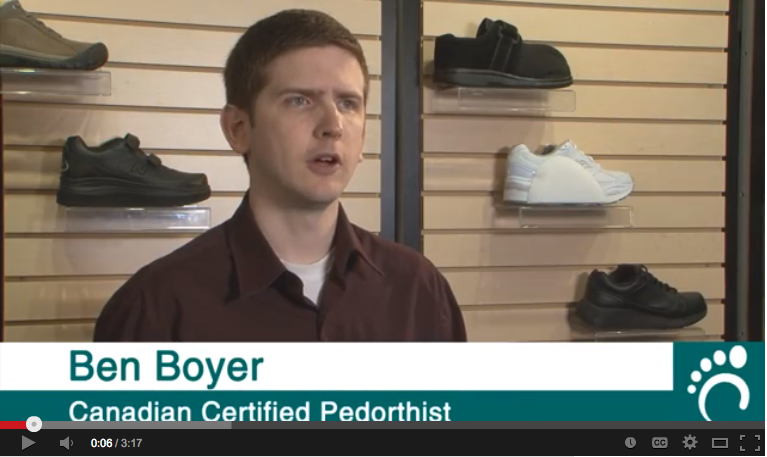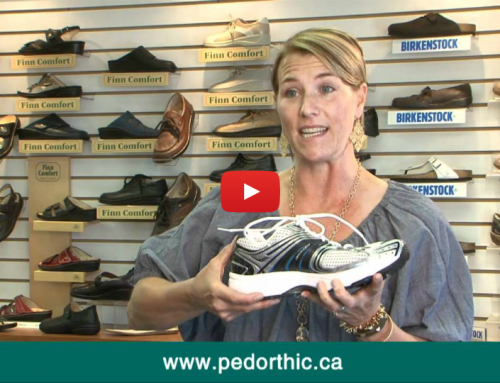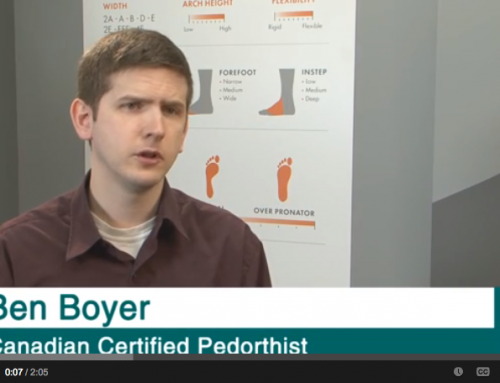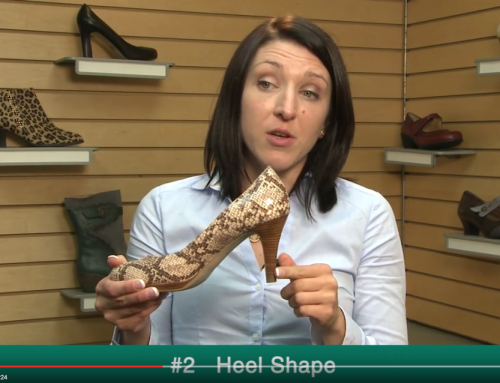To help improve mobility and comfort, Canadian Certified Pedorthists offer modified or ultra-patient shoes to exactly meet the shape and requirements of their feet and lower limbs. Pedorthic shoe modifications are considerably more cost-effective than creating custom shoes from scratch. Plus, shoe modifications have the advantage of using brand name athletic and leather shoes as a foundation for a more contemporary look.
This shoe might look like a normal dress casual shoe but it’s actually chock full of orthopaedic goodies. This shoe has four modifications created in a pedorthic lab. The height of the shoe has been increased with a lift. Lifts give patients with different leg lengths a more level posture which improves their mobility and alleviates hip and back pain. To add a lift into a shoe, we first cut the sole off the existing shoe, either with a band saw or knife. Then we glue the lift material to the shoe and grind it to meet the exact shape of the sole. Next, we replace the sole of the shoe so it closely matches its mate shoe and provides good wear and traction. Lifts are the most common type of shoe modification made by Canadian Certified Pedorthists, since having different leg lengths is a common problem, especially for anyone who has had hip or knee replacement, or lower limb injuries.
Here you’ll see the buttress, which is a stiff wall we insert on one side of the shoe to provide extra support. Buttresses improve stability and relieve ankle, knee, hip and back pain. They’re helpful in preventing the patient from losing balance and reduce the risk of falls and ankle sprains. To create a buttress, first we mark the upper of the shoe where the material will go. The material we use for the buttress is a firm foam, which may be reinforced with graphite sheet material, depending on the patient’s needs. After we’ve prepared the side of the sole and the upper, we glue the buttress in place, and then cut and grind it to the shape of the shoe. Material is added to the outsole to make it level with the rest of the shoe.
Inside the shoe, we can do excavations to reduce pressure points from the bottom of the shoe. To create an excavation, we cut and grind away the sole material from inside the shoe with a knife or Dremel tool. Once the pit is dug into the bottom of the shoe, we fill it with a cushioning material and then smooth out the top. This creates a soft pocket to accommodate feet suffering from rheumatoid arthritis, complications of diabetes and anatomical bony prominences.
The last modification on this particular shoe is a balloon patch, which is designed to provide extra room inside the shoe for bony prominences, including severe bunions or hammertoes. To create a balloon patch, we first mark the desired location and size of the patch. Then we cut a hole in the upper of the shoe and stitch on a soft leather patch with the necessary extra space. In addition to providing extra comfort, balloon patches also minimize pressure and friction on the foot, which helps to prevent corns, calluses, and blisters.
There are many other types of modifications Canadian Certified Pedorthists make to shoes and many of our modifications don’t even have names because they’re custom designed for each patient’s specific needs. The magic of all these modifications is that they help ease patients’ pain and discomfort and put them back on the road for better mobility. For more information on how shoe modifications might benefit you, contact your local Canadian Certified Pedorthist.





